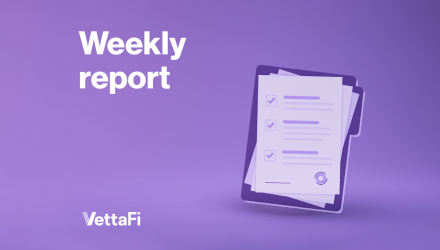Economic indicators are released every week to provide insight into the overall health and performance of an economy. They serve as essential tools for policymakers, advisors, investors, and businesses. That’s because they allow them to make informed decisions regarding business strategies and financial markets. In the week ending June 27, the SPDR S&P 500 ETF Trust (SPY) rose 0.22%. The Invesco S&P 500 Equal Weight ETF (RSP) was down 0.32%.
This article examines three important economic releases from the past week. Those are the personal consumption expenditures (PCE) price index, Q1 gross domestic product (GDP), and June’s consumer confidence index. These provide insights into the country’s economic landscape, with a particular focus on consumption and consumer attitudes. By understanding consumers’ attitudes toward the economy, we can gauge their spending patterns. That significantly impacts overall economic growth.
Personal Consumption Expenditures (PCE)
The Fed’s preferred inflation gauge rose at its slowest monthly rate in the past six months in May. The Core PCE Price Index measures inflation excluding volatile food and energy prices. It rose by 2.6% compared to the previous year, down from 2.8% in April. This is the first deceleration in core PCE since February. It remains at its lowest level since March 2021. Additionally, headline PCE also decelerated in May, slowing to 2.6%, as expected. On a monthly basis, headline PCE was flat while core PCE inched up by 0.1% from April. Both monthly increases are the smallest monthly change for each series since November of last year. The latest PCE numbers came in as expected. But they should provide some relief that inflation is cooling and making progress toward the Fed’s 2% target.

Gross Domestic Product (GDP)
The U.S. economy grew at its slowest pace in almost two years, according to the third estimate for Q1 2024 Gross Domestic Product (GDP). The economy expanded at a rate of 1.4%. That’s a significant slowdown from 3.4% in Q4 of last year. But it’s slightly higher than the previous estimate of 1.3%. The economy has expanded over the last seven quarters. But the latest figure marks the slowest pace of growth over that same period.

In the first quarter, three out of the four subcomponents contributed positively to real GDP. Consumer spending was the largest contributor to last quarter’s economic growth. However, it was revised lower for each of the past two estimates. Business investment and government spending also made positive contributions, specifically in housing and at the state and local government levels. Net exports were the sole negative contributor last quarter, as imports — which are a subtraction in the calculation of GDP — increased.

Consumer Confidence Index
U.S. consumer confidence slightly weakened in June, as the Conference Board Consumer Confidence Index fell to 100.4 from a downwardly revised 101.3 in May. Consumer confidence has now declined for four of the past five months. This is due to consumers continuing to report mixed feelings about their current and future situations.
The index is based on a monthly survey measuring consumer attitudes about current and future economic conditions. It has a particular focus on employment and labor market conditions. The overall decline this month is largely reflected in consumers’ pessimistic outlook about future labor market conditions, income expectations, and business conditions. Meanwhile, consumers’ confidence levels in the present situation improved slightly for a second straight month. That is due to increased optimism regarding labor market conditions.
The Consumer Discretionary Select Sector SPDR ETF (XLY) is tied to consumer confidence.
Economic Indicators and the Week Ahead
The labor market will be in focus this week as several key job reports will be released. The May JOLTS data and June employment reports will provide insights into the health of the labor market, a vital element of the overall economy. The labor market has been, and will continue to be, closely watched as it is one of the key elements driving the Federal Reserve’s policy decisions.
On Tuesday, the Bureau of Labor Statistics will release the latest job openings data, where we’ll see if job openings continue to fall after dropping to their lowest level since February 2021 in last month’s report.
On Wednesday, ADP will release its latest employment report that will set the stage for the more comprehensive BLS employment report due on Friday. Expectations are that 180,000 nonfarm jobs were added in June, down from 272,000 in May, and that the unemployment rate remained at 4.0%.
For more news, information, and analysis, visit the Innovative ETFs Channel.









